ClarkVision.com
| Home | Galleries | Articles | Reviews | Best Gear | Science | New | About | Contact |
My Very Portable Astrophotography, Landscape and Wildlife Photography Setup
by Roger N. Clark
| Home | Galleries | Articles | Reviews | Best Gear | Science | New | About | Contact |
by Roger N. Clark
My goal in photography gear is to buy good equipment that I can use for multiple types of photography: multiple use. My multi-use requirements include very low light astrophotography to fast action wildlife photography, to landscape photography. Further, the setup must be portable enough to travel to remote places, including easily on airplanes. I have achieved my goals.
The Night Photography Series:
Contents
Introduction
The Portable System
The Assembled System
Conclusions
References and Further Reading
Whether I'm going to a local wildlife area, or a dark sky site, or traveling thousands of mile by air, I want a portable system that can excel at wildlife action photography, landscapes, nightscapes, and the very low light deep sky astrophotography of galaxies, nebulae and star clusters. And I want all this in a light package that I can carry. Here I'll show my current system that meets all these requirements and weights less than 70 pounds, including lenses, 2 camera bodies, tripod, astro tracker mount, tripod heads, batteries, and the cases to hold it all. The performance of such a small system is astounding. The tracker and tripod can also be removed from the carrying case and put on my backpack so I can hike to remote locations with under 50 pounds.
With a setup like I describe here, I can go to remote places, from National Parks in the US, to the Serengeti, even traveling by small plane and still carry the full system. And all this with stock cameras--no special modifications for astrophotography. The same camera that is ideal for astrophotography is also ideal for wildlife action photography.
2019 Update. I am now also using a Fornax Lightrack II. Both the Astrotrac and the Lightrack II are ultralight trackers with excellent tracking accuracy. The Astrotrac is no longer in production but may be found used. The Lightrack II is in production and may be found new. See Fornax Mounts: http://fornaxmounts.com/products/lightrack.html
Example images with my system are shown in Figure 1a and 1b.
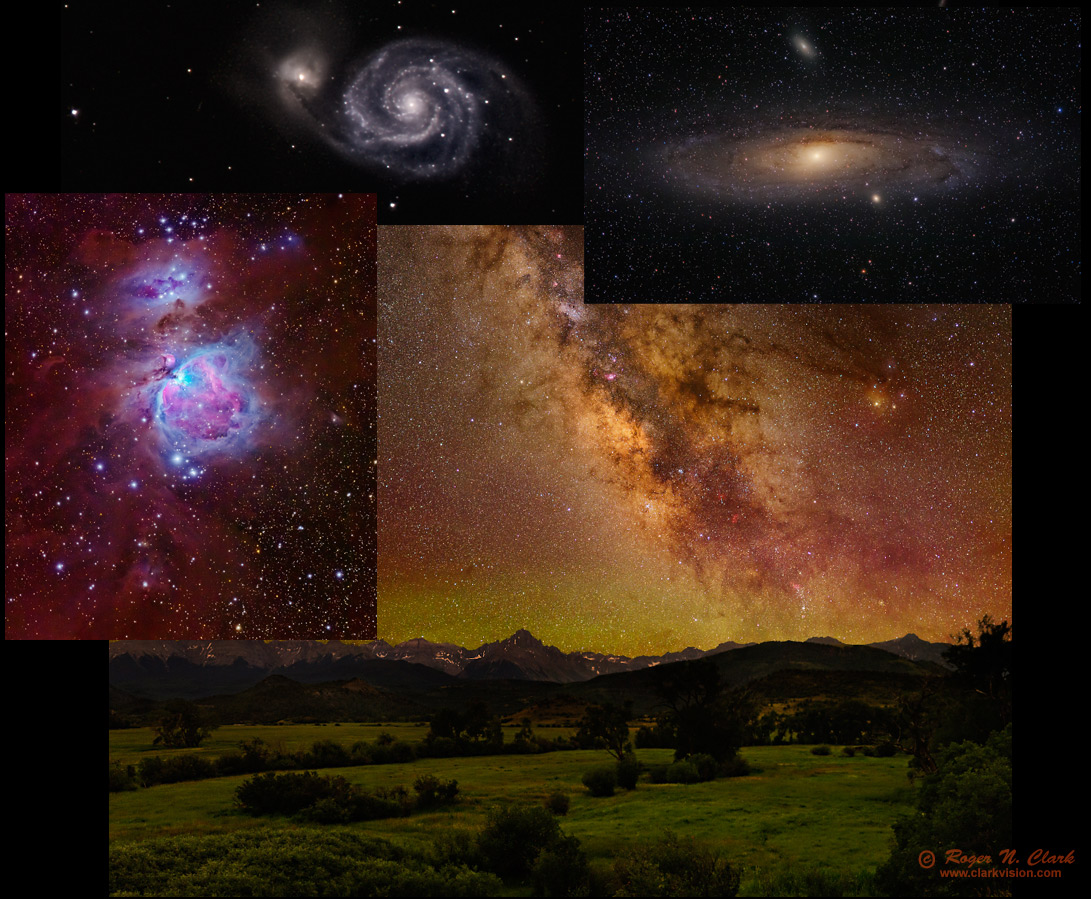
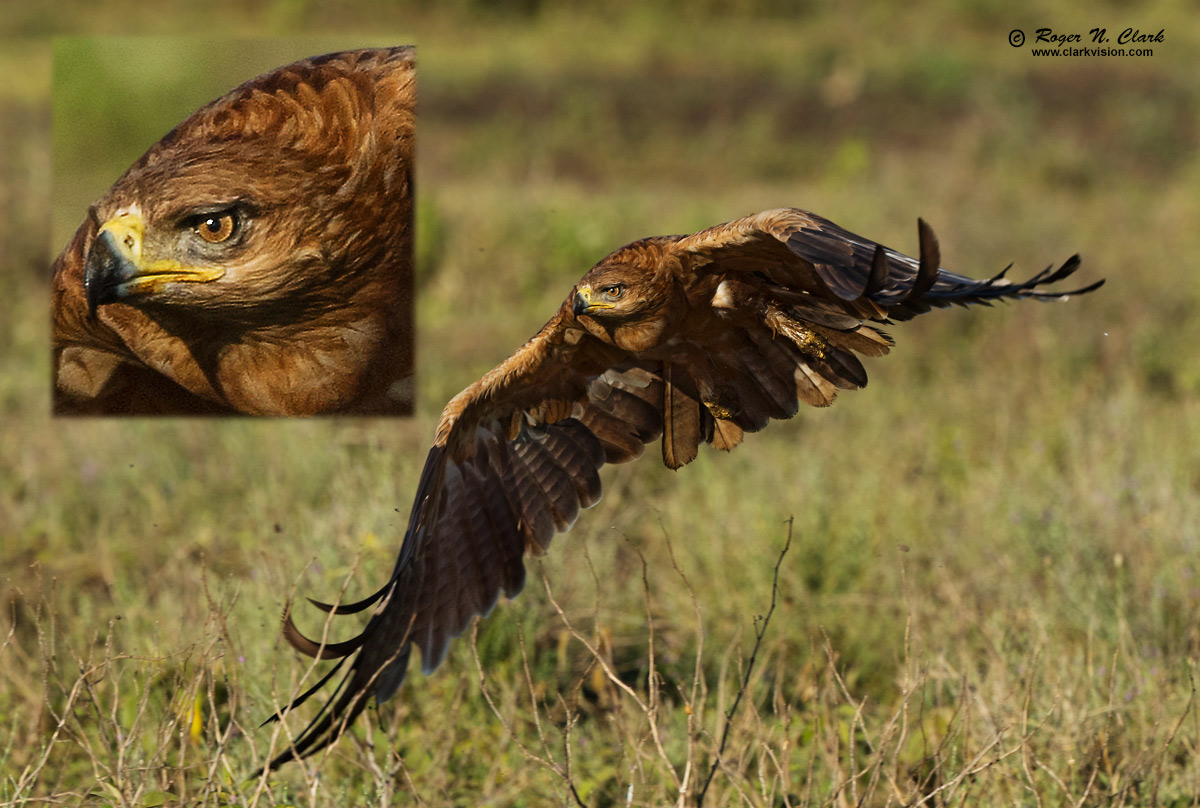
The packed system is shown in Figure 2. Of course I wear the backpack and roll the Pelican case if the surface is smooth. The cameras and lenses in the photo backpack are shown in Figure 3 and the contents of the Pelican case are shown in Figure 4.

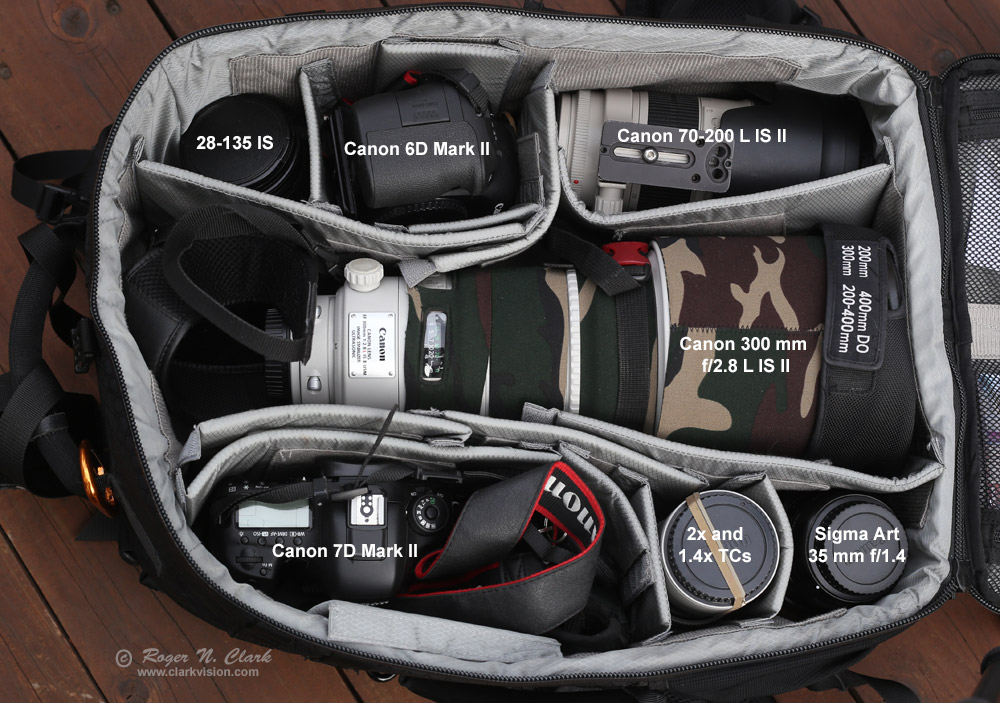
The photo backpack contains the following gear.
Cameras:
Canon EOS 6D Mark II DSLR Camera
or sometimes I carry a
Canon 6D 20-megapixel digital camera
Canon EOS 7D Mark II DSLR Camera
Lenses: Canon EF 300mm f/2.8L IS II USM Lens with Canon Extender EF 1.4X III and Canon Extender EF 2X III
EF 70-200mm f/2.8L IS II USM Lens, Sigma 35 mm f/1.4 DG HSM lens, Canon 28-135 IS lens,
Gura Gear 32L backpack (older). Current equivalent is: Gura Gear G Elite G32 Pro Camera Backpack
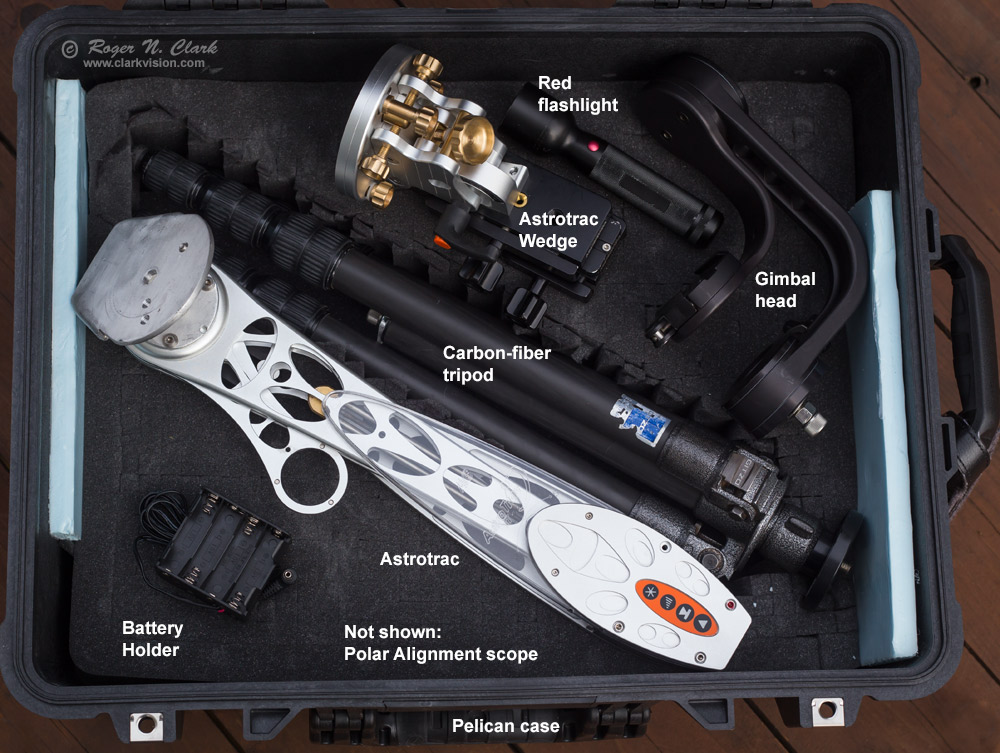
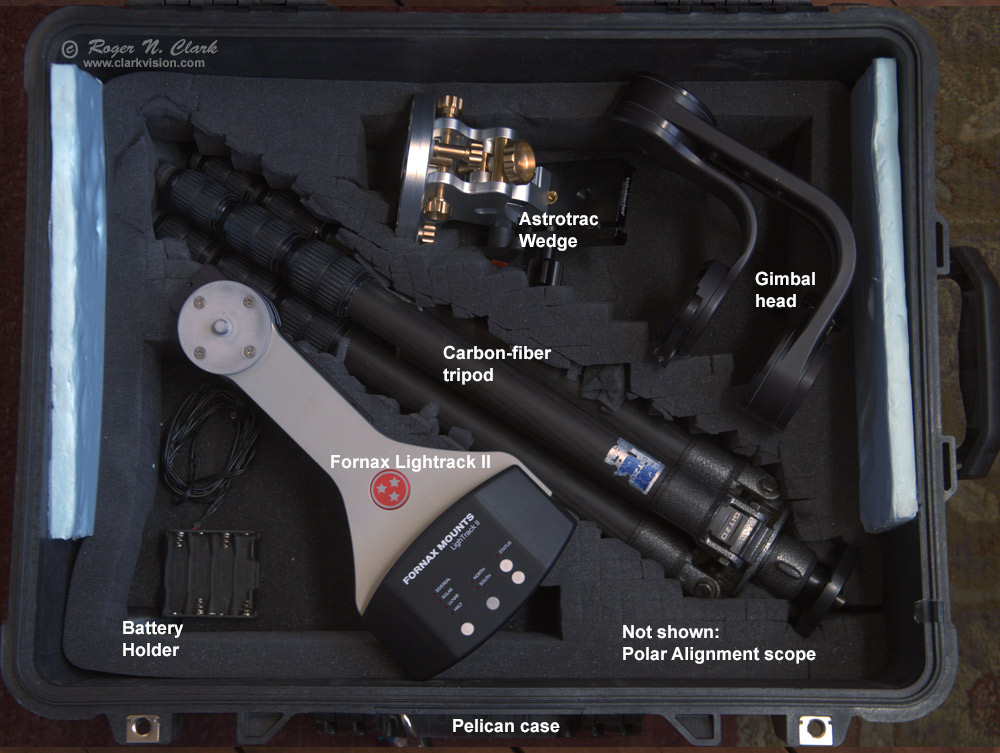
Pelican 1560 Case with Foam Set (Black)
Contents:
AstroTrac TT320X-AG,
Gitzo 1228 carbon fiber tripod. Equivalent current model:
GIGT1545T Traveler Series 1 Carbon Fiber Tripod
Tripods up to 22 inches folded length will fit in the Pelican case.
For longer tripods, use a larger Pelican case, like 1615Air Wheeled Check-In Case (Black, with Pick-N-Pluck Foam)
Tripod heads: Arca Swiss MonoBall for the small tripod, the new model: Monoball Z1 sp (Single Pan) Ballhead with 3/8" Screw - Supports 130 lb (59 kg)
The ball head needs a clamp. I use Wimberley clamps (Arca-Swiss compatible): C-12 Quick Release Clamp (2.5", 6.4 cm Long)
With a ball head, this adapter makes a gimbal mount. I use this combination up to 200 mm. Arca Sidekick Ball to Gimbal Head Adapter
Wimberley gimbal mount
For deep sky astrophotography on the astrotrac, this works extremely well.
Wimberley WH-200 Gimbal Tripod Head II with Quick Release Base
NOT RECOMMENDED: At this time I strongly do not recommend the 4th generation gimbal head. It looks like they have a great light weight gimbal head, so I bought one. Out of the box I tested the clamps and one axis froze. I have tried contacting the company multiple times for a YEAR AND A HALF. I even wrote a review on their website thinking they would see it in their approval process and contact me. I only got a response after many months. If a company can't stand by their products, do not buy from them. I have never ever made such a recommendation, and waited 1.5 years for a response before making a public comment. I had to modify the locking system in my machine shop to get a workable product. The Gimbal head in Figure 4 is this modified head.

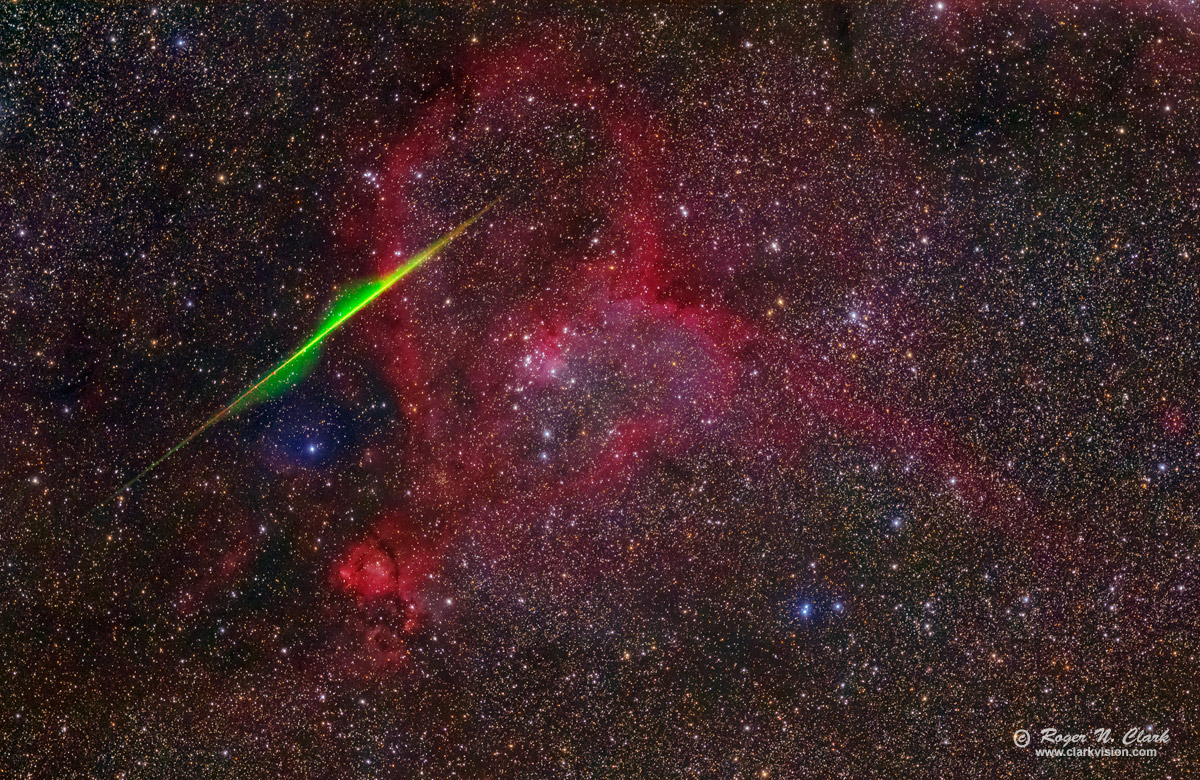

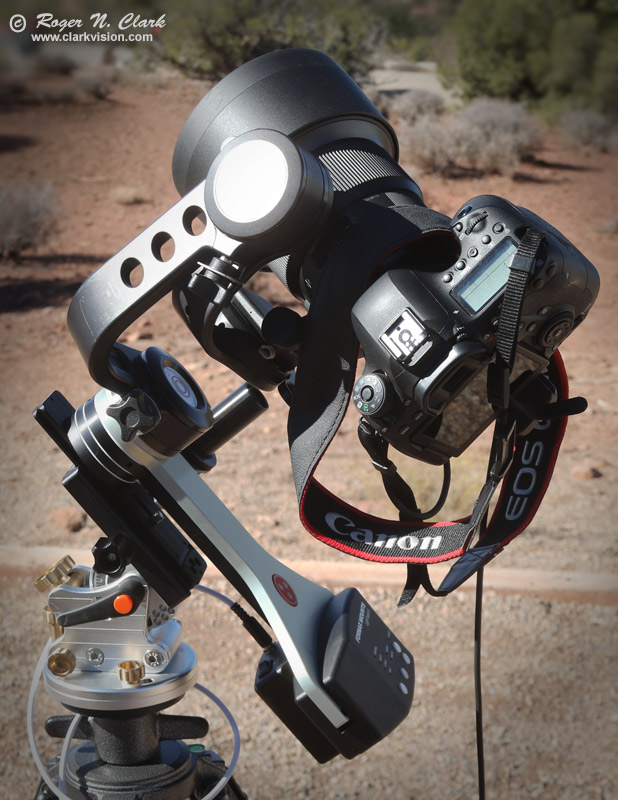
The products listed here make it possible to have a multi-use landscape, nightscape, wildlife action, and deep-sky astrophoto setup in an extremely portable system. The system is easily taken on airplanes, including small aircraft. Note the Pelican case must be checked baggage on airlines as it is too large for carry-on. The system can be taken to remote locations in a backpack if you can carry about 50 pounds, or a little less by selecting only one camera and fewer lenses.
References and Further Reading
Clarkvision.com Astrophoto Gallery.
Clarkvision.com Nightscapes Gallery.
Clarkvision.com Action Gallery
If you want to do certain types of imaging, choose the right tools. Sometimes
gear matters.
Before choosing cameras and lenses, see:
Does Gear Matter in Photography?
For more general low light, night, and astro photography, see this article:
Characteristics of Best Digital Cameras and Lenses for Nightscape and Astro Photography
For specific recommendations on lenses and cameras for low light, night, and astro photography, for a variety of manufacturers, see: Recommended Digital Cameras and Lenses for Nightscape and Astro Photography
The Night Photography Series:
| Home | Galleries | Articles | Reviews | Best Gear | Science | New | About | Contact |
http://clarkvision.com/articles/portable-astro-landscape-wildlife-setup/
First Published January 23, 2018
Last updated January 29, 2019